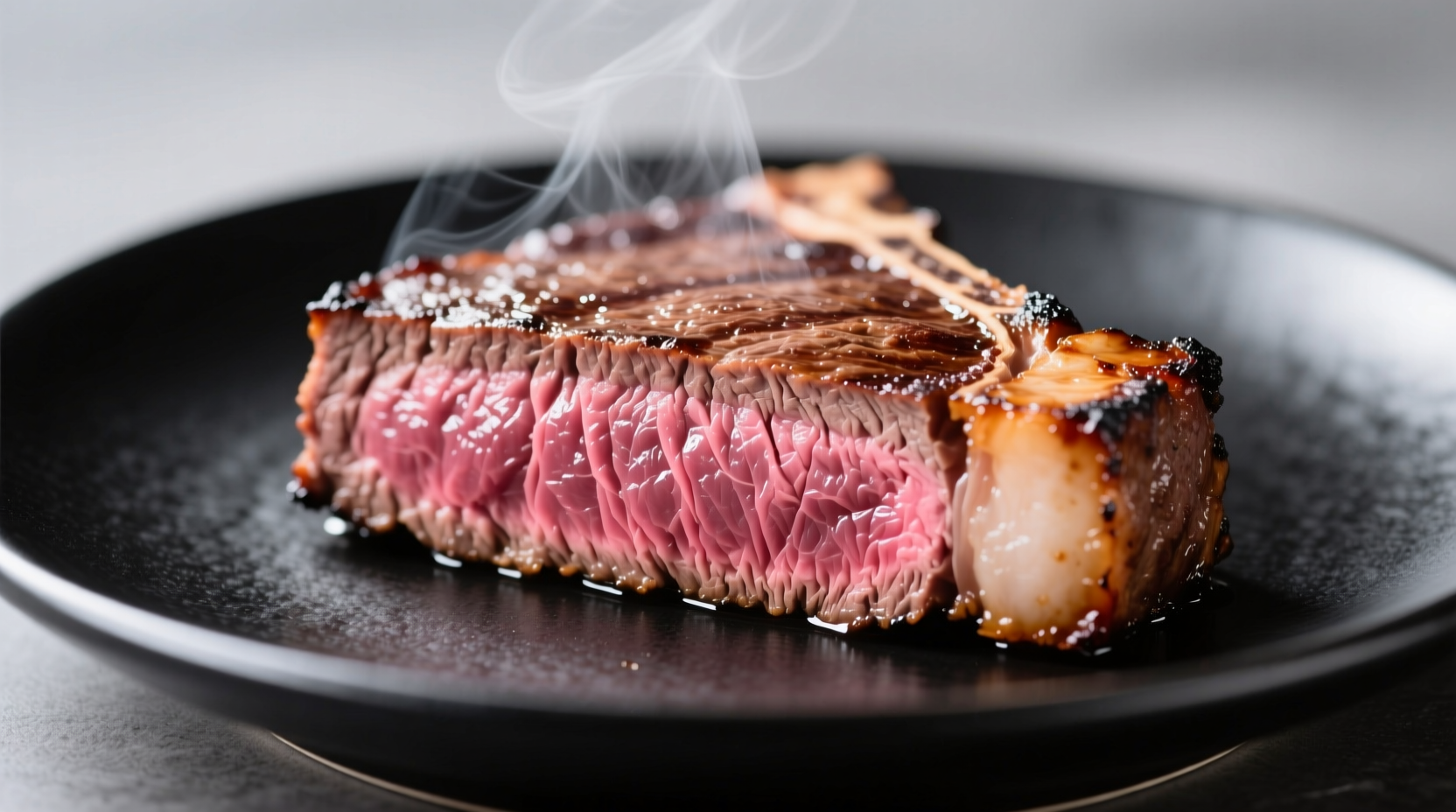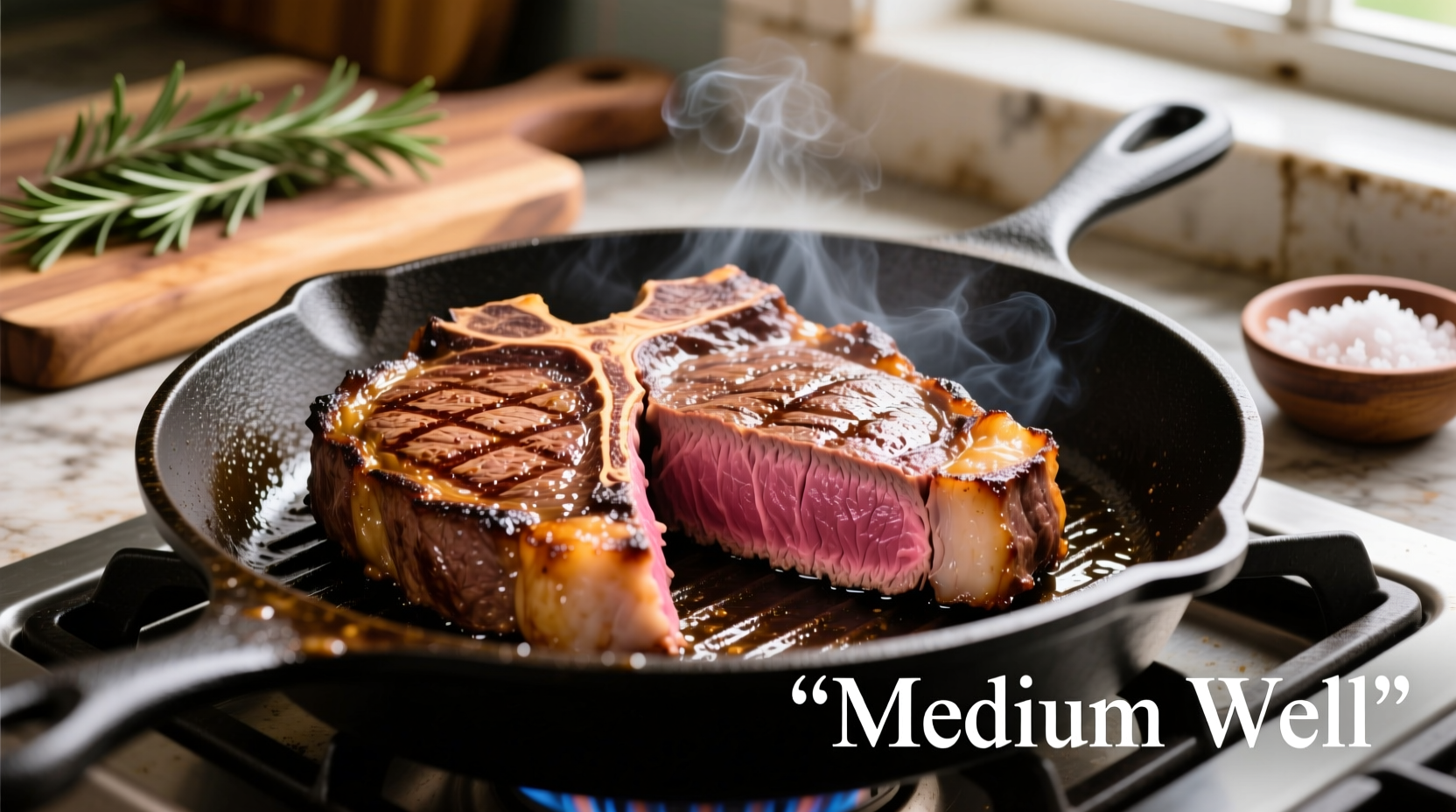Perfect medium well steak reaches 150-155°F (65-68°C) internal temperature with just a hint of pink in the center. This guide delivers a foolproof 7-step method using any cooking surface, with precise timing charts and visual doneness cues so you'll never overcook steak again.
What Exactly Is Medium Well Steak?
Medium well steak registers between 150-155°F (65-68°C) internally, showing only a thin band of pale pink at the very center before transitioning to gray-brown throughout. Unlike well done steak, it retains some moisture while meeting food safety standards for vulnerable populations. The USDA Food Safety and Inspection Service confirms that beef cooked to 145°F with 3-minute rest time reaches safe consumption levels, but medium well provides an extra safety margin for those preferring minimal pink.
| Doneness Level | Internal Temperature | Center Appearance | Texture |
|---|---|---|---|
| Medium Rare | 130-135°F (54-57°C) | Bright red | Soft, juicy |
| Medium | 135-145°F (57-63°C) | Pink | Firm but yielding |
| Medium Well | 150-155°F (65-68°C) | Faint pink ring | Firm with slight give |
| Well Done | 160°F+ (71°C+) | Gray-brown throughout | Very firm, dry |
Why Temperature Matters More Than Timing
While timing charts provide general guidance, steak thickness, starting temperature, and cooking surface dramatically affect results. The American Meat Science Association emphasizes that internal temperature remains the only reliable doneness indicator. Carryover cooking—the continued temperature rise after removal from heat—adds 5-10°F during resting, so always remove steak 5°F below target temperature.
Your Medium Well Steak Preparation Checklist
Follow these preparation steps before heating your cooking surface:
- Choose appropriate cuts: Ribeye, strip steak, or filet mignon (1-1.5 inches thick) work best for medium well without excessive drying
- Bring to room temperature: Remove steak from refrigerator 30-60 minutes before cooking for even heat distribution
- Dry the surface: Pat thoroughly with paper towels—critical for proper searing
- Season simply: Generous salt and freshly ground black pepper (avoid sugary rubs that burn at medium well temperatures)
- Prep thermometer: Insert probe-style thermometer sideways into steak's center

Step-by-Step Cooking Method for Perfect Results
1. Preheat Your Cooking Surface
Whether using cast iron, grill, or stainless steel, heat to 400-450°F. Test readiness by flicking water droplets—they should sizzle and evaporate instantly.
2. Sear the First Side (3-5 minutes)
Place steak on hot surface without moving. Listen for aggressive sizzling—this indicates proper sear development. Flip when steak releases naturally.
3. Sear the Second Side (2-4 minutes)
After flipping, insert thermometer horizontally through the side. For 1-inch steaks, begin checking temperature at 5 minutes total cook time.
4. Monitor Temperature Closely
Remove steak at 145°F (63°C)—5°F below target—to account for carryover cooking. This critical step prevents overcooking, which dries out medium well steak.
| Steak Thickness | Stovetop Time (per side) | Grill Time (per side) | Target Pull Temp |
|---|---|---|---|
| 1 inch | 3-4 min / 2-3 min | 4-5 min / 3-4 min | 145°F (63°C) |
| 1.5 inches | 4-5 min / 3-4 min | 5-6 min / 4-5 min | 145°F (63°C) |
| 2 inches | 6-7 min / 4-5 min | 7-8 min / 5-6 min | 145°F (63°C) |
5. Rest Properly (Critical Step!)
Transfer steak to cutting board or warm plate, tent loosely with foil, and rest for 5-10 minutes. During this time, juices redistribute and temperature rises to final 150-155°F. Skipping this step causes juice loss when cutting.
6. Verify Final Doneness
Cut a small slit in the thickest part to check center color. Proper medium well shows only a narrow pink ring (about 1/8 inch) surrounded by gray-brown meat. If needed, return briefly to heat—but check every 30 seconds.
Avoid These 3 Common Medium Well Mistakes
1. Overcooking During Resting
Pulling steak at target temperature instead of 5°F below guarantees dry, well done results. The USDA Food Safety and Inspection Service confirms that carryover cooking continues the cooking process even off-heat.
2. Cutting Too Soon
Resting allows muscle fibers to relax and reabsorb juices. Cutting immediately after cooking releases up to 40% more juice according to American Meat Science Association research.
3. Using Low-Heat Methods
Slow cooking methods like sous vide require precise temperature control (140°F for 1-2 hours followed by sear) that most home cooks struggle with. High-heat methods provide more forgiving results for medium well steak.
When Medium Well Works Best (And When to Choose Other Doneness)
Medium well suits thicker cuts (1.5+ inches) and tougher steaks like round or chuck that benefit from longer cooking. It's ideal when serving vulnerable populations including elderly diners or pregnant women who prefer minimal pink. However, for premium marbled cuts like ribeye under 1.5 inches, medium (135-140°F) preserves more juiciness while still being safe.
FAQ: Medium Well Steak Questions Answered
How can I tell medium well doneness without a thermometer?
Use the hand test: Press your thumb to ring finger—medium well matches the firmness of your palm below the thumb. Alternatively, check for slight resistance when pressing center with tongs.
Why does my medium well steak always turn out dry?
Most dryness comes from overcooking past 155°F or skipping the resting phase. Always pull at 145°F and rest 5-10 minutes. Marbled cuts like ribeye retain more moisture at medium well than lean cuts.
Can I cook medium well steak in the oven?
Yes—sear in cast iron first, then finish in 400°F oven until reaching 145°F internally. This method works best for steaks thicker than 1.5 inches where stovetop cooking might overchar the exterior.











 浙公网安备
33010002000092号
浙公网安备
33010002000092号 浙B2-20120091-4
浙B2-20120091-4